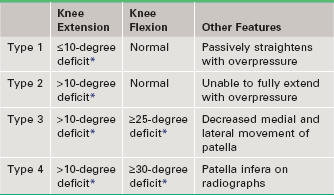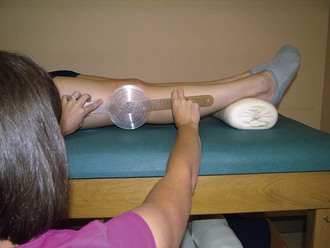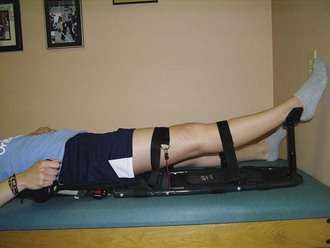Chapter 90 Arthrofibrosis of the knee results in the loss of extension, and in some patients loss of knee flexion also occurs. Loss of knee extension is usually more symptomatic compared with loss of flexion.1 Normal ROM of the knee may include some degree of hyperextension and varies from person to person. Therefore ROM of the uninvolved knee must be assessed first to gain a comparison point, and any difference between the uninvolved and involved knee ROM is noted as a deficit. Hyperextension of the knee is often overlooked, but is a normal finding in most knees. DeCarlo and Sell2 found that 95% of males and 96% of females have some degree of knee hyperextension; the mean for males was 5 degrees, and the mean for females was 6 degrees. Knee extension must be assessed with the patient supine and both heels propped on a bolster, allowing the knees to fall into hyperextension (Fig. 90-1). Unless extension is measured this way and compared with that of the opposite, normal knee, a slight loss of knee extension could easily be overlooked. The amount of knee extension and flexion loss is noted and can be used to classify the severity of arthrofibrosis to assist with treatment planning (Table 90-1).3 TABLE 90-1 Classification of Arthrofibrosis3 *All range-of-motion deficits are based on comparison with the range of motion of the normal, uninvolved knee. A Merchant view radiograph,4 in which both patellae are viewed, can be used to detect disuse osteopenia in the involved patella. This is a sign that the patient has been significantly favoring the involved leg by standing with the weight shifted onto the uninvolved leg and avoiding use during other activities of daily living. Owing to the difficulty in regaining knee extension in patients with arthrofibrosis, we routinely prescribe the use of a passive knee extension device (Kneebourne Therapeutic, Noblesville, IN) in this patient population (Fig. 90-2). This device provides a patient-controlled, sustained stretch to the knee to help patients regain symmetrical knee extension, including hyperextension. The patient can use this device independently at home three to five times per day for 10 to 15 minutes per session. Patients also perform towel stretch (Fig. 90-3), prone hang, and heel prop exercises to improve knee extension. In addition, patients work to improve quadriceps muscle control with the goal of regaining the ability to perform an active heel lift (Fig. 90-4) and achieve active hyperextension.
Management of Arthrofibrosis of the Knee
Preoperative Considerations

Imaging
Rehabilitation
![]()
Stay updated, free articles. Join our Telegram channel

Full access? Get Clinical Tree


Management of Arthrofibrosis of the Knee








